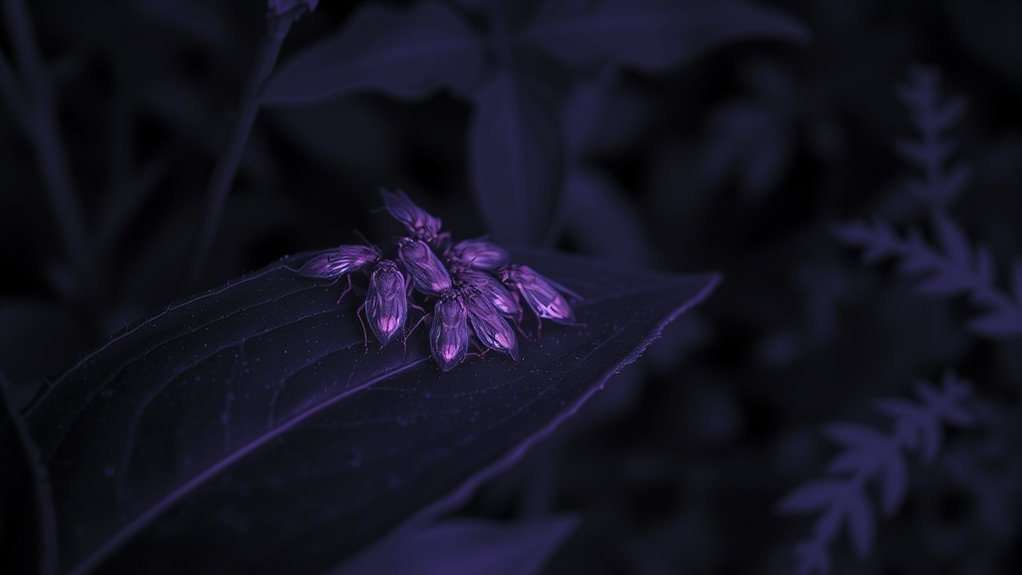Infrared light helps cameras see in low-light conditions by detecting heat or invisible wavelengths. However, many insects are attracted to infrared and heat sources, mistaking them for food or mates. This attraction can cause insects to gather around your camera, potentially interfering with footage or triggering false alarms. Understanding how insects respond to infrared can help you set up your camera more effectively. If you’re curious about how this interaction works and how to minimize issues, keep exploring.
Key Takeaways
- Insects are attracted to infrared and heat emitted by cameras, mistaking it for food or mates.
- Infrared light is invisible to humans but detectable by specialized cameras, aiding low-light detection.
- Thermal cameras detect heat signatures, which can attract insects or cause false triggers in footage.
- Adjusting infrared settings and using physical barriers can reduce insect attraction and interference.
- Insect behavior varies with species and environment, influencing how they respond to infrared sources on cameras.

Infrared light plays a significant role in how cameras detect and capture images in low-light conditions, but it can also attract insects. When you use infrared-enabled cameras, especially those equipped for thermal imaging, you’re tapping into a spectrum of light invisible to the human eye. Thermal imaging captures the heat emitted by objects, making it invaluable for security, wildlife observation, or search-and-rescue operations. However, this same infrared light can influence insect behavior. Many insects are naturally attracted to heat sources and may mistake infrared emissions for food, mates, or suitable habitats. This attraction can lead to increased insect activity around infrared cameras, especially during nighttime.
Infrared light attracts insects by mimicking heat sources, increasing activity around thermal cameras at night.
Understanding the connection between infrared light and insect behavior is vital if you operate cameras outdoors or in environments where insects are prevalent. Insects such as moths, beetles, and certain flies are particularly sensitive to infrared wavelengths. When your camera emits infrared light, these insects detect the heat or light signatures and are drawn toward the source. This can be problematic, especially for wildlife researchers or security personnel, because insects may interfere with camera footage or become a nuisance in the field. Additionally, a swarm of insects around your infrared device can obscure the lens, reducing image quality or causing false triggers on motion sensors.
Thermal imaging technology works by detecting the heat radiated by living creatures, including insects. Since insects are warm-blooded relative to their surroundings, they emit noticeable thermal signatures that can be picked up by your camera’s sensors. This means that in environments rich in insect activity, thermal imaging can inadvertently highlight these tiny creatures as heat spots, sometimes confusing the camera’s system. Insect behavior around infrared sources can also vary based on species, temperature, and environmental conditions. Some insects are more attracted to heat, while others may avoid it altogether. Recognizing these patterns helps you better predict and manage insect activity around your equipment.
To minimize issues caused by insect attraction, you might consider adjusting your camera’s infrared settings or using physical barriers like mesh covers. Lighting strategies that reduce infrared emission can also help, especially if you don’t need thermal imaging. Being aware of how insects respond to infrared light allows you to plan your camera setup more effectively, ensuring clearer footage and less insect interference. Additionally, understanding AI vulnerabilities and insect responses can help in developing smarter, more resilient camera systems. Ultimately, understanding the science behind infrared light and insect behavior helps you make smarter choices when deploying infrared cameras, whether for surveillance, research, or outdoor observation.
Frequently Asked Questions
Can Insects See Infrared Light?
Insects generally can’t see infrared light because their infrared perception is limited or absent. They rely on camouflage strategies to blend into their environment, but infrared light isn’t part of their visual spectrum. You might think they detect heat signals, but they mostly respond to visible wavelengths. So, while infrared light affects cameras and can reveal hidden features, insects don’t perceive it directly, relying instead on other sensory cues.
How Do Insects Respond to IR Illumination?
Imagine you’re a moth drawn irresistibly to a porch light—that’s how insects respond to IR illumination. They use infrared detection to sense warmth and movement, often mistaking IR sources for natural cues. This attraction impacts insect behavior, increasing their activity around IR-lit areas. Understanding this helps explain their responses, showing how IR illumination can unintentionally attract insects, influencing their navigation and feeding patterns.
Do Different Insect Species React Differently to IR?
Yes, different insect species react differently to IR because of variations in their Infrared perception. Some insects are more attracted to IR illumination, which can influence insect attraction during camera monitoring. Others may not notice IR light at all, showing little to no response. Your understanding of these differences helps in designing better IR lighting setups, ensuring effective observation while minimizing disturbance to certain insect species.
Are There Insects That Are Attracted to IR Light?
Yes, some insects are attracted to infrared light due to infrared attraction. While most insects rely on visible light and insect vision, certain species, like moths, may respond to infrared signals, especially if they mistake them for their prey or mates. Your understanding of insect vision helps explain this behavior, as some insects can detect or be attracted to infrared light, influencing how they interact with various light sources.
How Does IR Illumination Affect Insect Behavior?
Infrared illumination is like a silent magnet, subtly influencing insect behavior. Since many insects have infrared sensitivity, they may be attracted or disturbed by IR light, affecting their natural patterns. Their insect vision often extends beyond human perception, making IR light a hidden factor in their activity. When you use IR illumination, you might unintentionally alter insect movement, drawing them in or repelling them without realizing it.
Conclusion
So, now you see how infrared light reveals what’s hidden, how it attracts insects, and how your camera captures the unseen. You understand the science behind the glow, the bugs’ response, and the technology at work. You can now recognize the power of infrared, appreciate its role in nature and photography, and realize its potential to uncover mysteries. Embrace the knowledge, explore the possibilities, and let infrared light open new worlds for you.









